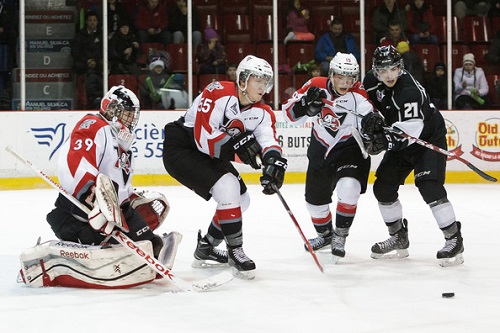Developing and Winning
This past trade deadline has shown the Avalanche trading for their first possible rental since Patrick Roy and Joe Sakic took control of the Colorado Avalanche organization. Then they made a second rental trade by bringing in Mikkel Boedker. These trades have shown a divide in thinking among Avalanche fans that I have found fascinating. Half seem to be on board with bringing in Shawn Matthias and Mikkel Boedker while the other half is upset at the bleeding of prospects/picks in these trades.
These trades are not completely unusual for teams looking to compete in the playoffs. Chicago, Los Angeles, Anaheim, Boston, etc. have all made rental-type trades at one point or another in the past two seasons. This year is really the first year that the Avalanche have made a move for a UFA-to-be and didn’t immediately sign him to a contract extension. So for everyone this is unchartered territory with regard to the new Avalanche FO.
Developing and winning are not mutually exclusive ideas which is why the title is not “Developing vs. Winning”. Generally the idea is that if you develop well you will start to win more. It’s an idea which is working in Tampa Bay who had some bad years then started getting reinforcements from their development system which has led to their current successes. Naturally you see the Tampa success and want it to be implemented by your own organization which is struggling. In this case the Colorado Avalanche.

And this is where the outrage comes from. After spending three drafts stacking up on prospects, two of them are traded away along with two more draft picks for future drafts. Trading Connor Bleackley and Kyle Wood automatically decreases the talent in the prospect pool while moving the 3rd round pick and 4th pick decrease the chances of finding prospects to replace them. As an organization and a fandom that has been voicing concerns about the prospect pool since 2009, it comes as a shock when two Top 10 Avalanche prospects are moved out of the organization.
That is the cost of winning sometimes though; selling part of the future in order to better the team in the now. The problem then becomes, who do you move out and who do you keep? Very few prospects are surefire NHLers. Out of a 30 player prospect pool you might have 5 players that will play in the NHL as a regular (could be a regular 4th liner though). So that leaves 25 prospects whose futures are up in the air. In fact those players are so hard to predict that one could end up looking slightly better one season then the next season another prospect could completely outstrip them and end up bumping them down as is what happened with Stefan Elliott and Tyson Barrie.
It’s why trading prospects as young as Kyle Wood and Connor Bleackley is seen as risky because you have two prospects that are in the above average category that have lots of time to grow. Whereas trading a nearly fully developed Colin Smith is less of a risk because by now you have a clearer idea as to what kind of player he is going to turn into.
A possible bigger problem with the Boedker trade is that both Wood and Bleackley are a part of the 2014 NHL Draft class. The 2014 draft class will be making their jump into the AHL/ECHL next season. The Colorado Avalanche AHL team has always been a struggling team so receiving young, talented reinforcements would have been preferred. Now the Avalanche will be relying on players from Round 4 and higher to begin their pro journey with the San Antonio Rampage. Connor Bleackley, Kyle Wood, Julien Nantel, and Alex Pepin look a lot better than Julien Nantel, Alexis Pepin and Sergei Boikov (2015 draft overager) coming in to the Avalanche pro system.
So when looking at the 2014 Draft for the Colorado Avalanche we are seeing possibly the weakest draft since Patrick Roy and Joe Sakic took over which has took another dive due to the Boedker trade. Sometimes these drafts happen. When selecting players as young as 17 years old it’s going to be very difficult to project their career path which ultimately leads to drafts where it’s not perfect and the prospects just don’t pan out. The problem with the Avalanche is that this is happening all too often which results in the poor prospect pools fans have been seeing for years now.
2010 NHL Draft the Colorado Avalanche only have one player in the pro system and that is goaltender Calvin Pickard. 2011 NHL Draft the Avalanche only manage to grab one NHL player in Gabriel Landeskog on a gimme pick while Duncan Siemens is the only player in the AHL from the draft for the Avalanche. The 2012 NHL Draft only has 3rd rounder Troy Bourke still in the pro system. The cycle is finally broken with the 2013 NHL Draft where we have both Nathan MacKinnon and Chris Bigras in the NHL.

So in three NHL Drafts the Colorado Avalanche have two players in the NHL while in just the 2013 Draft the Colorado Avalanche managed to have the same amount of players reach the NHL. If we look at the same time period for the Tampa Bay Lightning (2010-2012 Drafts) we can why drafting/developing is important:
2010 Tampa Draft: Brett Connolly & Radko Gudas (Both traded but both did contribute)
2011 Tampa Draft: Vladislav Namestnikov, Nikita Kucherov, Nikita Nesterov & Ondrej Palat
2012 Tampa Draft: Andrei Vasilevskiy & Cedric Paquette
That is eight players who have made it to the NHL in the same time period for the Tampa Bay Lightning as the two players who have made it to the NHL for the Colorado Avalanche. This right here is the reason many Avalanche fans were outraged at the trade deadline. No one wants the 2013 NHL Draft to be the lone good draft in the middle of a streak of bad ones like the 2009 NHL Draft was for the Avalanche. No Avalanche fan wants to keep trading away the future for a playoff spot every season.
However it’s not so completely black and white on the trading of prospects and draft picks. There are times where you will have to move prospects out, not just to win but to make for a loss in terms of a prospect not quite reaching his potential or progressing as he should. For Tampa that was Brett Connolly who as a 6th overall pick was not meeting expectations so was traded. For the Avalanche it is Connor Bleackley whom they believe is not progressing as they hoped he would.
Now is essentially giving up on Bleackley the correct choice to make? We won’t know for a while what that answer is. Right now the Avalanche are turning expiring or depreciating assets into current assets. It’s something that the Dallas Stars are doing with success. It’s a form of asset management that the current Avalanche organization has been doing for the past two seasons.
The conclusion of this issue of whether trading off prospects/picks for rentals, or at all, is the Avalanche’s situation is not entirely simple. As mentioned above there needs to be a balance between developing and winning. You need to make sure you actually have a prospect pool along with ensuring that your AHL team is stocked properly.

There comes a point though where winning in the NHL will overrule some decisions made at the development level because that is the whole point. You need to win at the NHL level. That is the whole point of developing. Sometimes development has two meanings: 1) Developing a prospect into a contributing NHL player 2) Developing a prospect into a tradable asset. And number 2 is where Kyle Wood comes in. With the current Avalanche prospect defensive depth a boom or bust type of defender such as Kyle Wood could serve as a trade piece for target such as Mikkel Boedker.
Now that we have seen the Avalanche Front Office take that next first step in the managerial world, they will need to ensure that they have proper depth before they make any more trades such as the Boedker one because right now the Avalanche are back to teetering on the edge of losing that valuable prospect depth they have built up over the past three drafts.
To sum it ALL up, the moves made at the deadline are not franchise crippling. However Connor Bleackley, Kyle Wood, the 3rd round pick and 4th round pick are not completely expendable with the need to properly develop prospects in order to contribute at the NHL level. Management has made a choice to start winning and they will need to smartly balance the need to develop and the need to win.
Geremy McFadden, Canada, eurolanche@eurolanche.com
17/03/2016 - 20:00




